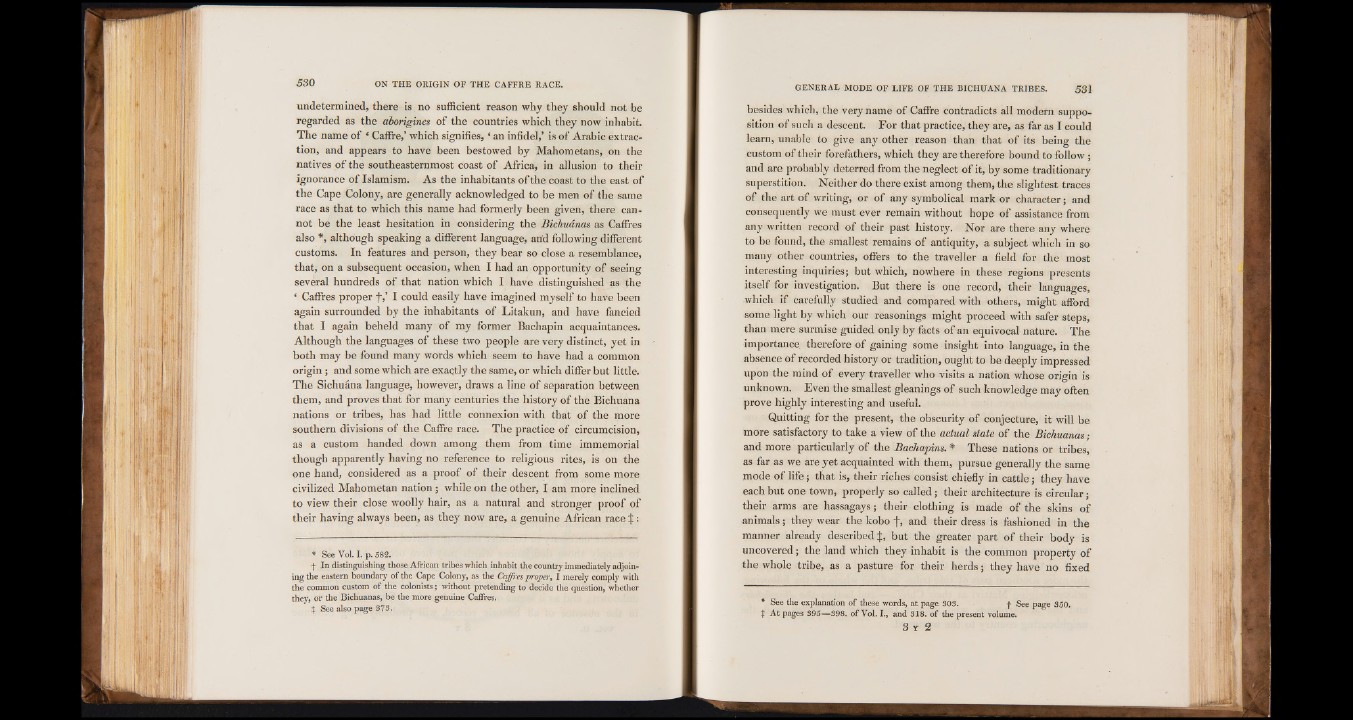
undetermined, there is no sufficient reason why they should not be
regarded as the aborigines of the countries which they now inhabit.
The name of I Caffre,’ which signifies, t an infidel,’ is of Arabic extraction,
and appears to have been bestowed by Mahometans, on the
natives of the southeasternmost coast of Africa, in allusion to their
ignorance of Islamism. As the inhabitants of the coast to the east of
the Cape Colony, are generally acknowledged to be men of the same
race as that to which this name had formerly been given, there cannot
be the least hesitation in considering the Bichuanas as Caffres
also *, although speaking a different language, and following different
customs. In features and person, they bear so close a resemblance,
that, on a subsequent occasion, when I had an opportunity of seeing
several hundreds of that nation which I have distinguished as the
‘ Caffres proper f,’ I could easily have imagined myself to have been
again surrounded by the inhabitants of Litakun, and have fancied
that I again beheld many of my former Bachapin acquaintances.
Although the languages of these two people are very distinct, yet in
both may be found many words which seem to have had a common
origin; and some which are exaqtly the same, or which differ but little.
The Sichuana language, however, draws a line of separation between
them, and proves that for many centuries the history of the Bichuana
nations or tribes, has had little connexion with that of the more
southern divisions of the Caffre race. The practice of circumcision,
as a custom handed down among them from time immemorial
though apparently having no reference to religious rites, is on the
one hand, considered as a proof of their descent from some more
civilized Mahometan nation ; while on the other, I am more inclined
to view their close woolly hair, as a natural and stronger proof of
their having always been, as they now are, a genuine African race $ :
* See Vol. I. p. 582.
f In distinguishing those African tribes which inhabit the country immediately adjoining
the eastern boundary of the Cape Colony, as the Caffres proper, I merely comply with
the common custom of the colonists; without pretending to decide the question, whether
they, or the Bichuanas, be the more genuine Caffres.
$ See also page 373.
besides which, the very name of Caffre contradicts all modern supposition
of such a descent. For that practice, they are, as far as I could
learn, unable to give any other reason than that of its being the
custom of their forefathers, which they are therefore bound to follow ;
and are probably deterred from the neglect of it, by some traditionary
superstition. Neither do there exist among them, the slightest traces
of the art of writing, or of any symbolical mark or character; and
consequently we must ever remain without hope of assistance from
any written record of their past history. Nor are there any where
to be found, the smallest remains of antiquity, a subject which in so
many other countries, offers to the traveller a field for the most
interesting inquiries; but which, nowhere in these regions presents
itself for investigation. But there is one record, their languages,
which if carefully studied and compared with others, might afford
some light by which our reasonings might proceed with safer steps,
than mere surmise guided only by facts of an equivocal nature. The
importance therefore of gaining some insight into language, in the
absence of recorded history or tradition, ought to be deeply impressed
upon the mind of every traveller who visits a nation whose origin is
unknown. Even the smallest gleanings of such knowledge may often
prove highly interesting and useful.
Quitting for the present, the obscurity of conjecture, it will be
more satisfactory to take a view of the actual state of the Bichuanas;
and more particularly of the Bachapins. * These nations or tribes,
as far as we are yet acquainted with them, pursue generally the same
mode of life; that is, their riches consist chiefly in cattle; they have
each but one town, properly so called; their architecture is circular;
their arms are hassagays; their clothing is made of the skins of
animals; they wear the kobo j-, and their dress is fashioned in the
manner already described J, but the greater part of their body is
uncovered; the land which they inhabit is the common property of
the whole tribe, as a pasture for their herds; they have no fixed
* See the explanation of these words, at page 303. f See page 350.
t At pages 395—398. of Vol. I., and 318. of the present volume.